Physical Address
304 North Cardinal St.
Dorchester Center, MA 02124
Physical Address
304 North Cardinal St.
Dorchester Center, MA 02124
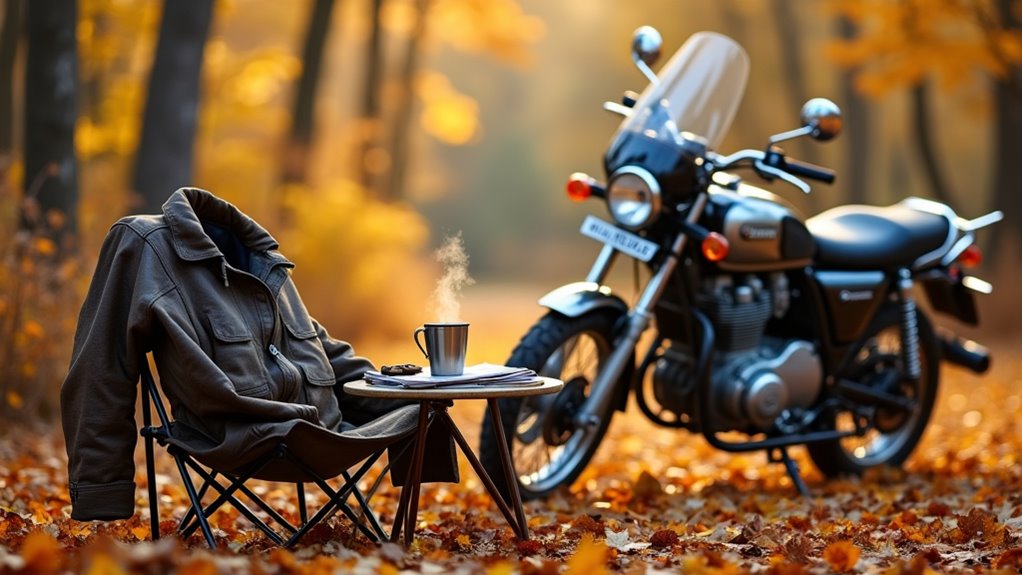
Hit the fall trails safely with essential biker camping hacks that transform chilly adventures into unforgettable experiences you'll want to repeat.
You’re facing shorter days and dropping temperatures, but that doesn’t mean your motorcycle camping adventures have to end. Fall offers some of the best riding conditions and stunning scenery, yet it demands smarter preparation than summer trips. Your gear choices, route planning, and safety considerations all shift when autumn weather becomes unpredictable. The key lies in making strategic adjustments that won’t break your budget while keeping you comfortable and safe on those crisp morning rides.
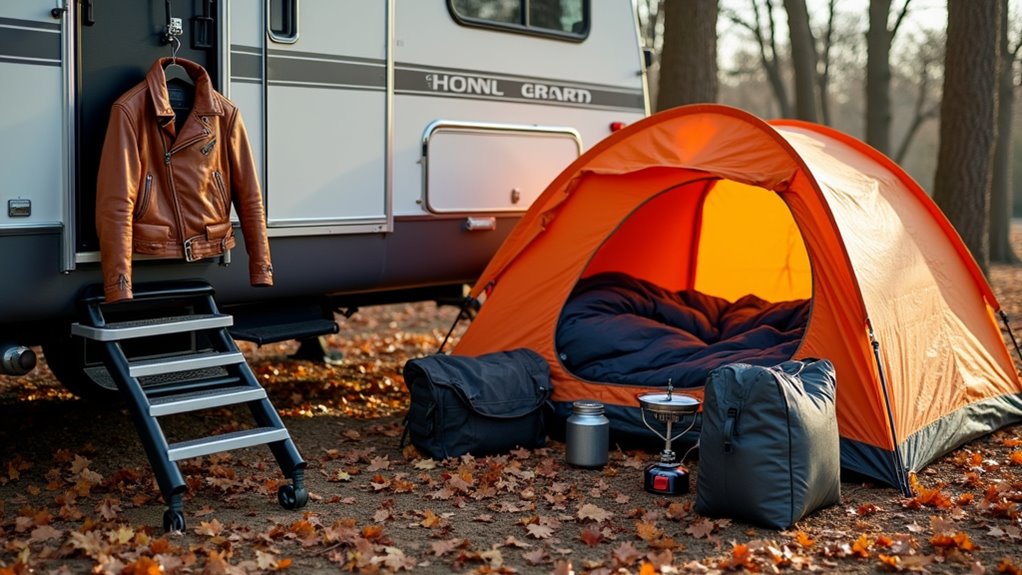
When autumn’s crisp air starts nipping at your riding gear, you’ll need to make some smart adjustments to your camping setup without breaking the bank. Your summer sleeping bag won’t cut it anymore—invest in a temperature-rated bag or add a fleece liner to your existing one.
Swap out your mesh tent panels for solid ones to block wind and retain heat. Pack extra base layers instead of bulky jackets since they compress better in your limited storage space. Don’t forget waterproof gloves and boot covers—wet extremities make for miserable rides.
A compact camp stove windscreen becomes essential as breezes intensify. Finally, upgrade to a four-season tent footprint to prevent ground moisture from seeping through during those dewy autumn mornings. Consider whether renting camping gear makes more financial sense than purchasing items you’ll only use seasonally, especially for expensive four-season equipment.
As temperatures drop and riding conditions become more challenging, you’ll need a strategic layering system that works both on the bike and around camp.
Start with moisture-wicking base layers—synthetic materials or merino wool work best and won’t break the bank.
Quality base layers don’t have to cost a fortune—synthetic blends and merino wool deliver excellent moisture management at reasonable prices.
Your mid-layer should provide insulation while allowing movement; fleece jackets or down vests are perfect choices.
For your outer shell, invest in a quality windproof and waterproof jacket that you can easily remove when you stop.
Don’t forget your extremities—lightweight glove liners under your riding gloves and thin wool socks under thicker ones make a huge difference.
Pack layers that compress small and dry quickly.
This system lets you adjust your temperature without stopping frequently, keeping you comfortable mile after mile.
Remember that proper backpacking gear selection applies to motorcycle camping too, so choose items that serve multiple purposes and minimize weight in your saddlebags.
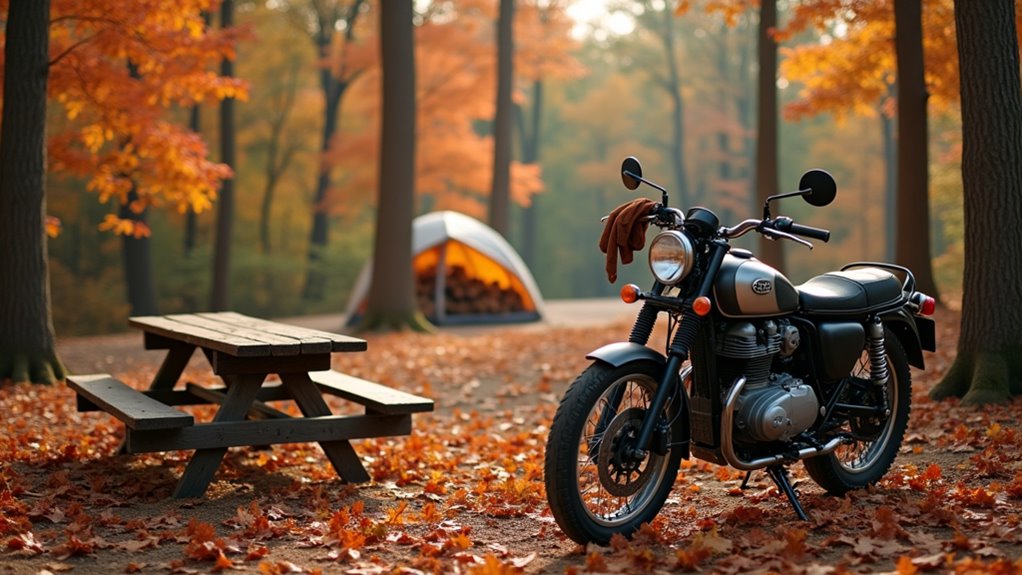
Fall camping presents unique opportunities and challenges that’ll shape your campground selection strategy. You’ll want facilities that accommodate motorcycle-specific needs while considering seasonal changes.
Look for campgrounds offering these essential features:
State parks often provide the best value with reliable amenities. Private campgrounds typically offer more services but cost more. Check seasonal closure dates, as many facilities reduce hours or close entirely after October.
Since fall weather can shift from sunny skies to torrential downpours within hours, you’ll need a solid weatherproofing strategy that protects both your motorcycle and camping gear without breaking the bank.
Start with affordable basics: heavy-duty trash bags and duct tape work wonders for emergency waterproofing. Invest in a quality motorcycle cover that’s both breathable and waterproof—it’ll protect your bike’s electronics and prevent rust formation overnight.
Pack your camping gear in waterproof stuff sacks or dry bags. You can’t afford soggy sleeping bags when temperatures drop.
Apply waterproofing spray to your tent’s seams and consider a footprint tarp underneath for extra ground moisture protection.
Keep rain gear accessible, not buried in your panniers. Weather changes fast, and you’ll want quick access when storm clouds roll in unexpectedly.
When severe weather forces you to hunker down, having camping activities ready can help pass the time and keep spirits up during extended delays.
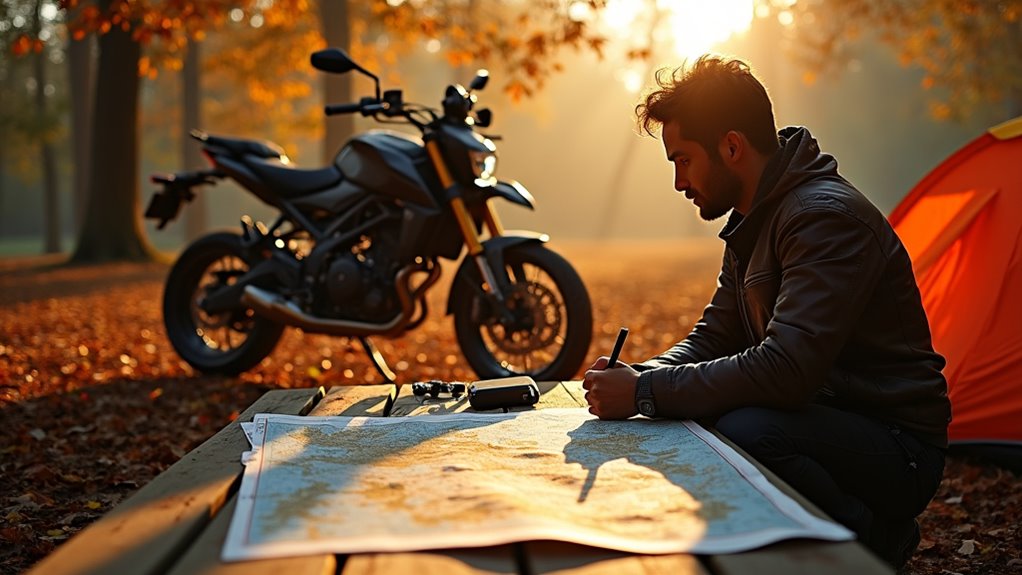
When daylight starts disappearing earlier each day, smart bikers adjust their travel schedule to squeeze every productive minute from the sun. You’ll want to start breaking camp earlier and identify stopping points before darkness hits unexpectedly.
Plan your route around these daylight-saving strategies:
Smart route planning around diminishing daylight hours maximizes riding time and prevents getting caught in darkness unprepared.
You don’t need expensive gear modifications. Simple schedule adjustments and forward-thinking will keep you riding safely while maximizing every available hour of natural light. While these tips focus on fall riding, similar principles apply to winter camping where daylight hours become even more precious and planning becomes critical for safety.
As temperatures drop and darkness settles in earlier, you’ll need reliable warmth that won’t break your budget or compromise safety. Always check campground fire restrictions before planning your evening warmth strategy. Keep your fire ring clear of overhanging branches and never leave flames unattended, even briefly.
For budget-friendly heating alternatives, consider a small portable propane heater designed for camping. They’re lightweight, motorcycle-friendly, and provide consistent heat without smoke or sparks.
Battery-powered heated blankets offer another affordable option that won’t drain your bike’s electrical system.
Pack extra thermal layers instead of relying solely on external heat sources. Merino wool base layers trap body heat effectively.
Store matches and lighters in waterproof containers, and always carry backup fire-starting materials like dryer lint or petroleum jelly-soaked cotton balls. Remember to completely extinguish your campfire by dousing it with water, stirring the ashes, and ensuring all embers are cold before leaving your campsite.
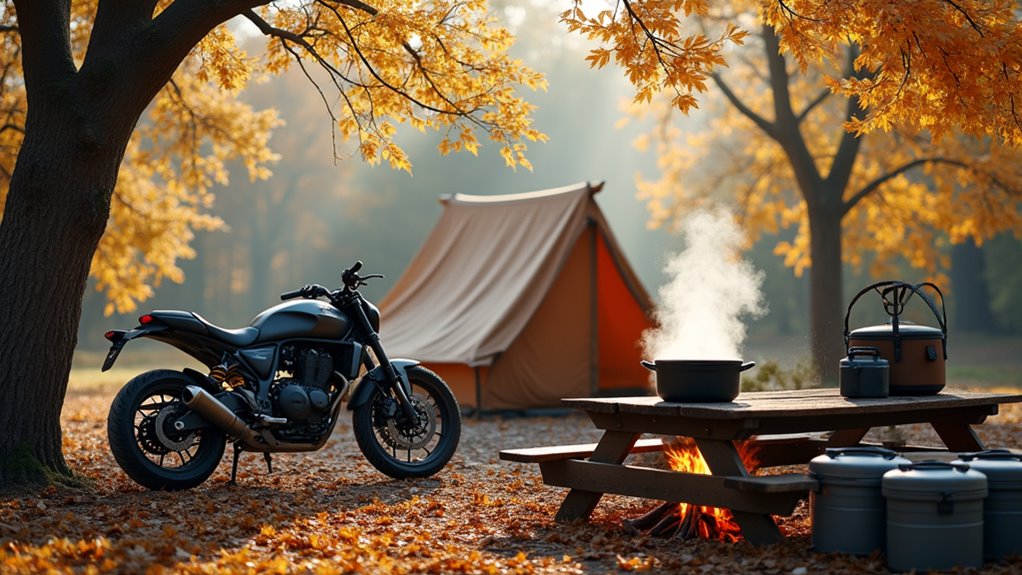
Cold weather transforms your motorcycle camping kitchen into a unique challenge that requires smart planning and gear adjustments. You’ll need to rethink your food storage and cooking approach when temperatures drop.
Store perishables in insulated containers closer to your body heat or bike’s engine warmth. Canned goods can freeze and burst, so keep them inside your tent overnight. Your camp stove will burn less efficiently in cold air, so pack extra fuel and use a windscreen.
If you’re camping in areas with potential snow conditions, carry an avalanche transceiver as part of your essential safety gear for emergency situations. Smart preparation keeps you fed and warm without breaking your budget.
Fall’s changing conditions demand heightened attention to your motorcycle’s most critical contact points with the road. Check your tire pressure weekly since temperature drops reduce PSI by roughly one pound per ten-degree decrease. Cold tires need proper warming before aggressive cornering – take those first few miles easy.
Inspect tread depth religiously. Worn tires become death traps on wet leaves and morning frost. You’ll need at least 2/32″ depth, but 4/32″ provides better wet-weather grip. Consider switching to dual-compound tires that offer enhanced wet traction without breaking your budget.
Clean your tires regularly, removing embedded debris that reduces contact patch effectiveness. Avoid painted lines, manhole covers, and leaf-covered surfaces when possible.
If you’re touring extensively, pack a portable tire gauge and emergency repair kit. Smart preparation beats expensive roadside assistance calls. For riders planning extended adventures, consider exploring backpacking opportunities across scenic routes where you can take a refreshing break from traditional tent camping.
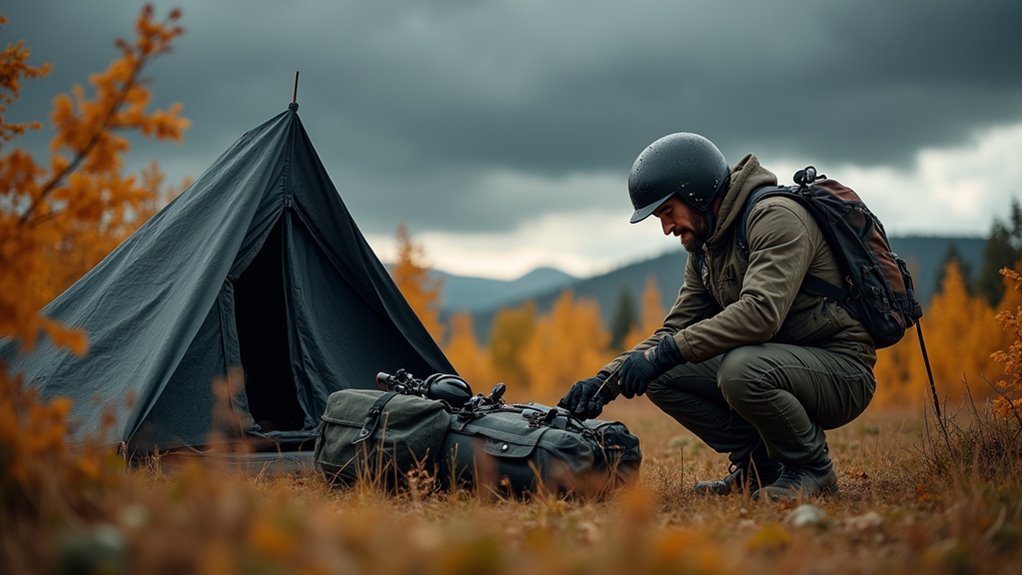
When weather turns nasty without warning, you’ll need more than good intentions to stay safe on two wheels. Fall’s unpredictable conditions can shift from sunshine to storms in minutes, making preparation essential for biker-campers.
Smart riders pack lightweight emergency gear that won’t break the bank or weigh down their bike. Your survival kit should include:
Check weather forecasts religiously, but don’t rely on them completely. Having backup plans and knowing alternate routes keeps you ahead of dangerous conditions.
For those seeking more extreme outdoor challenges beyond traditional camping, canyoneering adventures offer thrilling experiences navigating through slot canyons and rugged terrain.
Once you’ve weathered the storms, autumn’s brilliant colors reward patient bikers with some of the year’s most stunning scenery. Plan your routes through national forests and mountain passes where maples, oaks, and aspens create nature’s masterpiece.
Start early to catch golden hour lighting, and don’t forget your phone’s camera or a budget-friendly point-and-shoot.
Stop frequently at overlooks and pull-offs—you’ll discover hidden gems that GPS can’t predict. Capture wide shots of colorful valleys, then zoom in on detailed leaf patterns.
Pack extra batteries since cold weather drains them faster. Scout camping spots near scenic areas so you’re positioned for sunrise photography without breaking camp early.
When selecting gear for overnight photography trips, consider whether an internal frame backpack offers better weight distribution and stability for carrying camera equipment on challenging terrain.
Share your best shots with fellow bikers online to build community and discover new routes.
You’ve got your gear dialed in, your route mapped out, and your bike ready to roll. Fall motorcycle camping doesn’t have to break the bank—smart planning beats expensive gadgets every time. Pack light, layer smart, and stay flexible when Mother Nature throws you curveballs. Remember, the best adventures aren’t about having perfect conditions; they’re about being prepared for whatever comes your way. Now get out there and make some memories before winter sets in.